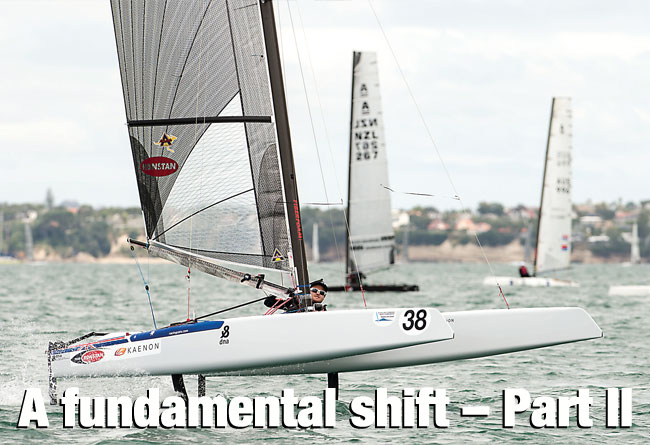
C-Class designer Steve Killing concludes his Little America’s Cup design review with a look at full foiling, and Guillaume Verdier has the inside track on Franck Cammas’s Groupama C
Full flight – the real answer
The science of the canted L-foil is not easy to comprehend. The accompanying renderings (page 36) show four phases of the ride height (the last being a recovery back to the first) and describe what is happening at each step.
Quasi-stable
In this phase the boat is riding comfortably on the tip of the foil and, without any changes in wind or boatspeed, the forces are in balance. The side force (blue arrow) is resisting the sail force of 450lb (for purposes of our discussion) and, combined with the vertical component of the red lift force, is balancing the 750lb weight of the boat.
Accelerating up
Any perturbation from the norm will upset the quasi-stable situation. The image illustrates an increase in lift due to higher boatspeed as the skipper bears off slightly. Side force remains constant at 450lb as that is linked directly to the stability of the boat and the sail sideforce.
However, the higher boatspeed creates more lift from the tip and now the hull has begun to rise, leaving less daggerboard shaft in the water. With a reduction in dagger board shaft area, the boat makes more leeway (the boat slides to the left in our illustration) – this added leeway is the key to the dynamic stability of the canted L-foil. The tip of the foil now has a component of flow approaching from left to right reducing the magnitude of the large red lift vector. The rise of the hull begins to slow.
Breaching
Sometimes the leeway effect alone will be enough to bring the boat back down to a reasonable ride height, but if the acceleration of the boat is great enough, as is the case with a windward mark bear-away, another safety valve is required. When the tip of the foil breaches the water’s surface there is a further loss in lift which is usually enough to counteract the upward inertia and gently bring the boat back down towards the quasi-stable condition.
We invite you to read on and find out for yourself why Seahorse is the most highly-rated source in the world for anyone who is serious about their racing.
To read on simply SIGN up NOW
Take advantage of our very best subscription offer or order a single copy of this issue of Seahorse.
Online at:
www.seahorse.co.uk/shop and use the code TECH20
Or for iPad simply download the Seahorse App at the iTunes store


